 Fans of either American football or rugby (both league and union) may well argue that the games are entirely different, and comparing them is akin to asking how is golf different from football.
Fans of either American football or rugby (both league and union) may well argue that the games are entirely different, and comparing them is akin to asking how is golf different from football.
Clearly, however, there are many similarities between the two sports, and for the sake of simplicity, as much as is possible we will treat rugby’s two codes as one sport in this article.
Here we will explain the fundamental ways in which they are different and in so doing draw attention to some of the ways in which they are alike.
Main Differences Between American Football And Rugby
Whilst some broad elements of the two sports are similar and the development of American football is closely linked to the history of rugby, there are several very simple, obvious and indisputable differences between the two.
Number Of Players
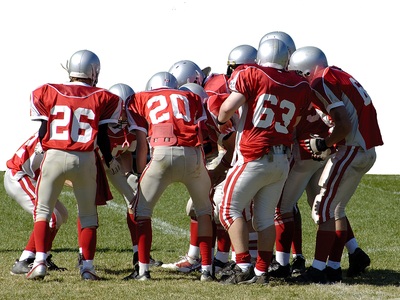 Rugby involves two teams of either 13 (league) or 15 (union) with a varying number of subs allowed depending on factors like the level of the game and the competition in which the teams are competing. Substitutions are usually limited, barring injuries, and are permanent.
Rugby involves two teams of either 13 (league) or 15 (union) with a varying number of subs allowed depending on factors like the level of the game and the competition in which the teams are competing. Substitutions are usually limited, barring injuries, and are permanent.
In contrast, American football involves teams of 11 players but there are three distinct units within each team: defence, offence and special teams.
A squad, usually called the roster, consists of up to 53 players in the National Football League (NFL) with the matchday group limited to no more than 46 of those. “Substitutions”, such as they are, are unlimited and rolling, meaning anyone can take up any position at any time during the game.
Timings
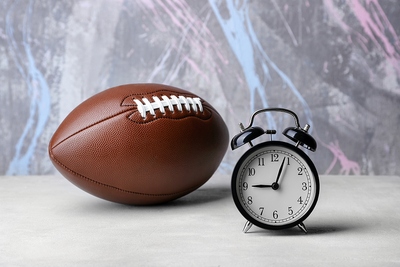 Rugby is played over two 40-minute halves with the clock running most of the time aside from certain stoppages. A 10 minute half time break takes place and each half ends once the last attack breaks down after the hooter or siren sounds, either by the ball going out of play or a penalty being awarded.
Rugby is played over two 40-minute halves with the clock running most of the time aside from certain stoppages. A 10 minute half time break takes place and each half ends once the last attack breaks down after the hooter or siren sounds, either by the ball going out of play or a penalty being awarded.
With the stoppages but excluding half time (which is sometimes 15 minutes) and excluding extra time, which may be played in the event of a tie, most games last around 90 to 100 minutes.
A game of American football is much shorter in theory, consisting of four 15-minute quarters, composing two 30-minute halves. Half-time is between 10 and 15 minutes, though longer for the game’s showpiece, the Super Bowl. Breaks between quarters are shorter, typically two minutes, whilst teams also have three timeouts per half where they can regroup and receive coaching.
However, the biggest factor is that the game clock is stopped for a wide range of actions, meaning that matches typically extend to over three hours and sometimes closer to four.
Passing
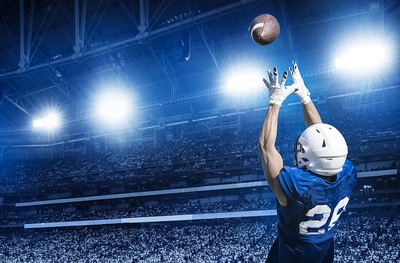 One of rugby’s core rules that dictates so much about the gameplay and how the action unfolds is that the ball can only be passed backwards.
One of rugby’s core rules that dictates so much about the gameplay and how the action unfolds is that the ball can only be passed backwards.
The precise interpretation of this rule has sometimes altered and you can pass the ball sideways but forward passes remain outlawed. The ball can, however, be kicked forward.
In contrast, most of the action in American football stems from the quarterback passing the ball forwards. Backwards and sideways passes are also allowed but forward passes are a key element of the sport.
That said, the ball can be passed backwards at any time but they can only pass it forwards once per down, a down being a phase of offensive play.
Scoring

The scoring systems are similar but different for rugby league, union and American football. Crossing the scoring line, a try in rugby or a touchdown in American football, offers the most points. In the latter this is worth six points, with an “extra point”, more typically referred to as the “point after” akin to a conversion, worth, unsurprisingly, an extra point. There is also the option for a two-point conversion though this is rarely attempted. In rugby league, a try is worth four points, whilst in union it is worth five, with the subsequent kick (the conversion) worth a further two points in both codes of the sport.
The next highest scoring option in American football is a field goal. This entails a placekick from a variable distance with the kicker attempting to propel the ball between the posts and over the crossbar. This is worth three points, with rugby having a drop goal worth three points in rugby union and one in league, that could be considered as being similar. The ball is drop kicked from open play and again must go between the posts and over the crossbar.
In rugby union penalty kicks are a common scoring method and these can also be viewed as similar to a field goal in American football. They are worth three points and involve a place kick (though drop kicks are also allowed) with the kicker again aiming to clear the crossbar. In rugby league penalties are a little less common as a scoring method and are worth two points.
The final scoring option in American football is a safety (worth two points), which is achieved by tackling the opposition offence in their own end zone (effectively behind their try line in rugby terms). These are rare, with a safety scored approximately once every 14 games.
Tackling And Blocking
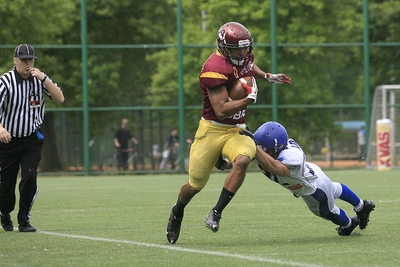 Tackling and the method of defending is very different in these two ostensibly similar sports.
Tackling and the method of defending is very different in these two ostensibly similar sports.
In American football, blocking is used in some passages and areas of play, but this would be classed as obstruction or worse in rugby.
At other times, American footballers are simply trying to bring a player to ground or force them off the field of play and the rules of how this can be done differ from a tackle in rugby.
There are subtle differences between the codes of rugby too.
Equipment And Padding
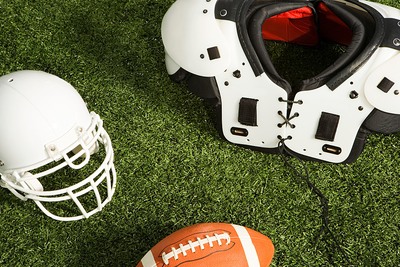 Rugby players wear minimal protective clothing, with extra equipment more or less limited to a soft headguard, gum shield and some form of ear protection, often crude taping.
Rugby players wear minimal protective clothing, with extra equipment more or less limited to a soft headguard, gum shield and some form of ear protection, often crude taping.
All of these are optional.
In contrast, American footballers wear extensive padding, including a hard helmet, shoulder pads, as well as protection on their hands, arms, legs and mouth.
This is mandatory and if a player’s helmet comes off they must not involve themselves in the play, with this rule having been changed over the years to become more draconian in order to protect the players.
Officials
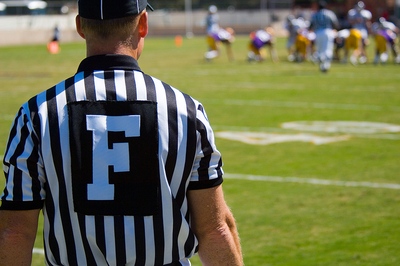 Rugby is generally officiated by a single on-field referee who uses what most UK fans would consider being the traditional referee’s implement of a whistle.
Rugby is generally officiated by a single on-field referee who uses what most UK fans would consider being the traditional referee’s implement of a whistle.
The ref is assisted by touch judges (who use flags with handles) and, depending on the code and level of the game, a video ref, timekeeper, substitute official and match commissioner. Whilst that sounds like a lot of officialdom, only the referee and touch judges are involved for much of the time.
In contrast, those new to the sport of American football may feel there are officials everywhere, possibly dressed as cartoon-style burglars.
The black and white striped uniforms of the seven standard officials really stand out, as do the many yellow “flags” that can appear on the pitch when one or more official spots a rules violation. These flags are actually more akin to weighted handkerchiefs and are thrown onto the pitch to indicate a foul.
Dimensions
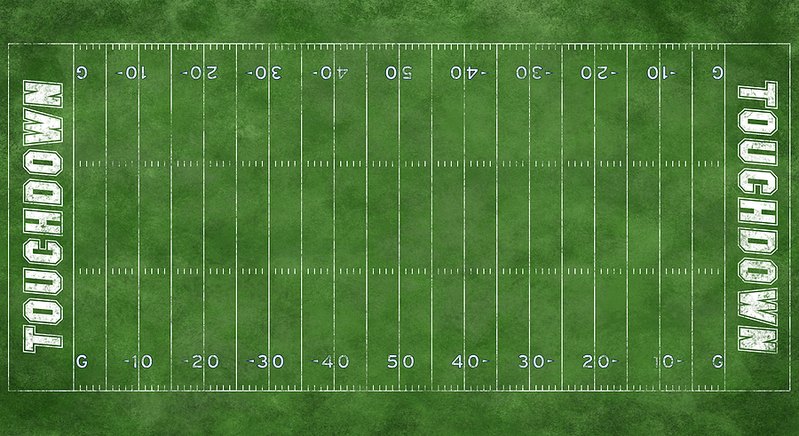
Whilst the ball, pitch and goals used in American football and rugby are broadly the same size and shape, they are still subtly different. Both sports use a rectangular pitch with a scoring zone extending beyond the goals at either end. The playing surface is bigger in rugby and there is no fixed size in either code. As well as being usually around 10-15% longer, rugby pitches are significantly wider than American football ones.
The pitches used for American football are a standard size: 100 yards in length from the start of one end zone to another, with two 10-yard end zones making for a total length of 120 yards. Pitches are 160 feet wide (around 53 yards). The pitch itself can be made from a synthetic surface or grass, whilst rugby is only ever played on grass.
Rugby pitches vary from around 115 yards right up to almost 160 yards including the try zones. They are usually around 75 yards wide. When it comes to the ball the roles are reversed and an American football is a shade longer, though it is slightly lighter. It is also pointier, making it more aerodynamic for the long forward passes that are a feature of the game, with a large-stitched seam that enables the quarterback to grip it more easily.
The goalposts are also slightly different, with those used in American football being supported by a single, central, vertical post. 10 feet above the playing surface this joins a horizontal crossbar that is 18 and a half feet long, upright posts then extending some 35 feet into the air from the end of this. Rugby posts are similar but use two supporting posts essentially creating an upper case ‘H’ shape. The crossbar is a little shorter, making for a goal around half a foot narrower, whilst the crossbar stands a shade under 10 feet so is a fraction lower than for American football. There is no fixed height of the overall goals but they must be at least 17 yards in total.
Participation
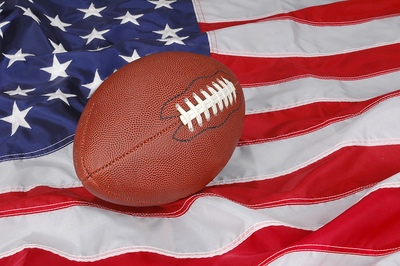 Whilst American football, rugby league and rugby union are all played to some degree around the world, there is no doubt that rugby has a greater claim to being a global sport.
Whilst American football, rugby league and rugby union are all played to some degree around the world, there is no doubt that rugby has a greater claim to being a global sport.
Aside from the major American league, the NFL, there is very little media interest in American football and no real international competition of note.
In contrast, rugby is very popular in many countries that were formerly in the British empire, such as Australia, South Africa, New Zealand, Fiji and other Pacific islands, as well as being played in all parts of the British Isles and France.
It is also reasonably popular in several other countries such as Argentina, Georgia, USA, Canada, Japan, Romania and Russia. International competition is a huge part of both forms of rugby, with the rugby union World Cup in particular being one of the globe’s major sporting events.
Finances
 Despite rugby having a much wider global reach, American football, or more accurately the NFL, is in a different world financially. The NFL has the highest average attendance of any major sports league in the world and tied to America’s huge population and rampant commercialisation that makes the sport, in America at least, one of the wealthiest in the world. With annual revenues of approximately $15bn the NFL is the most valuable league in the world and its showpiece, the Super Bowl, ranks as a huge global event despite what we have said about the sport’s insular nature.
Despite rugby having a much wider global reach, American football, or more accurately the NFL, is in a different world financially. The NFL has the highest average attendance of any major sports league in the world and tied to America’s huge population and rampant commercialisation that makes the sport, in America at least, one of the wealthiest in the world. With annual revenues of approximately $15bn the NFL is the most valuable league in the world and its showpiece, the Super Bowl, ranks as a huge global event despite what we have said about the sport’s insular nature.
In contrast, rugby is a pauper’s game. The very best stars earn excellent money and there is no doubt that elite players in the game’s heartlands are very wealthy. However, below that, many players, even professionals in the UK, do not earn vast sums. What’s more, even the best-paid rugby players earn nothing like the $128m that NFL star Carson Wentz reportedly pockets.
Wentz is one of a number of NFL players to feature in the Forbes list of the richest sports stars. No rugby players would get anywhere near this list, with NZ star Dan Carter probably the highest-paid player in the world with estimated earnings of around £1m per year.
Conclusion: Some Similarities But Many Differences
American football grew out of rugby and football (soccer), the first game being played in 1869. That it evolved, at least in part, from rugby explains many of the similarities. On the face of it, the sports use a similar ball, goal, pitch and scoring system, and the gameplay has a key commonality in that the aim is to get the ball from one end of the pitch to the other.
However, whilst some differences are minor, such as the exact length of the ball, where there is just a 1cm variation, others are significant. Probably the biggest single difference between American football and rugby is that the former allows the ball to be thrown forwards. This radically alters the entire sport, gameplay, tactics and strategy. Whilst the aim remains to get the ball over the scoring line, the fact that stars of the NFL can pass forward means the way in which they attempt to do so is often completely different to how their rugby counterparts go about a very similar aim.
